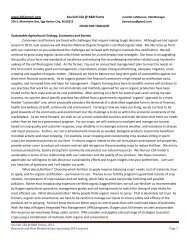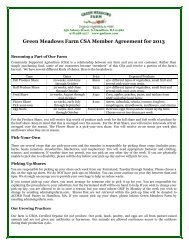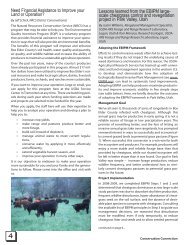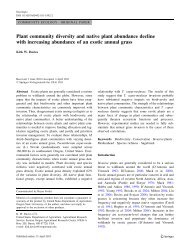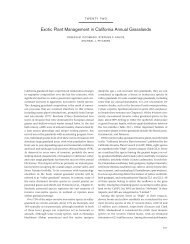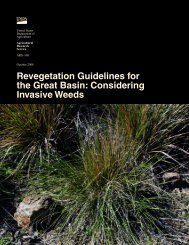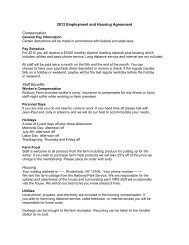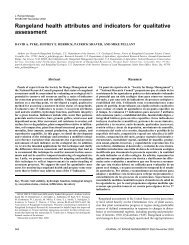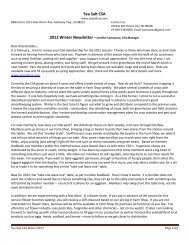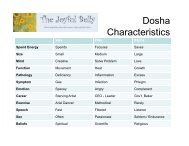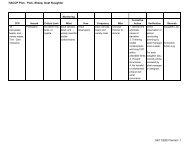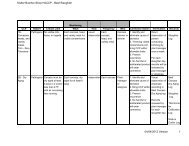“Green and Brown” Grazing Strategy
“Green and Brown” Grazing Strategy
“Green and Brown” Grazing Strategy
Create successful ePaper yourself
Turn your PDF publications into a flip-book with our unique Google optimized e-Paper software.
educe seed production, <strong>and</strong> control or prevent<br />
annual grasses. Within the context of an EBIPM<br />
program, managed grazing using the <strong>“Green</strong><br />
<strong>and</strong> <strong>Brown”</strong> strategy is primarily designed to<br />
alter relative species performance, but<br />
managers using grazing can also influence<br />
species availability <strong>and</strong> even site availability in<br />
creating different disturbances.<br />
The Dynamics of Grass Growth <strong>and</strong> the Response to <strong>Grazing</strong><br />
<strong>Grazing</strong> is considered a natural process in<br />
grassl<strong>and</strong>s. As a result of the process of<br />
grazing, livestock remove litter, recycle<br />
nutrients, stimulate tillering of perennial plants,<br />
<strong>and</strong> reduce seedbanks of competitive annual<br />
plants.<br />
There are two fundamental differences in life<br />
strategies between annual versus perennial<br />
grasses that allow l<strong>and</strong> managers to exploit<br />
them using grazing <strong>and</strong> these differences form<br />
the basis for the <strong>“Green</strong> <strong>and</strong> <strong>Brown”</strong> strategy.<br />
The first difference is annual grasses have a<br />
growth period different than many native<br />
perennial grasses <strong>and</strong> many non-native<br />
The photo above was taken in eastern Oregon in mid-March<br />
<strong>and</strong> illustrates the capacity of cheatgrass to germinate <strong>and</strong><br />
begin growth initiation earlier than perennials.<br />
10 - The Dynamics of Grass Growth <strong>and</strong> the Response to <strong>Grazing</strong><br />
perennial grasses as well. Annual grasses such<br />
as cheatgrass <strong>and</strong> medusahead germinate in<br />
the late-fall, winter or early-spring. Germination<br />
is prompted by precipitation occurring when<br />
temperatures are high enough for biological<br />
activity. Even when they germinate in the spring<br />
it is usually very early, prior to the time when<br />
most perennial grasses come out of winter<br />
dormancy <strong>and</strong> begin to grow.<br />
This difference makes invasive annual grasses<br />
temporarily more preferred <strong>and</strong> selected by<br />
livestock <strong>and</strong> sets up an opportunity to develop<br />
a grazing strategy that exploits this difference.<br />
It’s called <strong>“Green</strong> <strong>and</strong> <strong>Brown”</strong>. When invasive<br />
grasses are green, it indicates they<br />
are actively growing, very<br />
palatable, highly nutritious, <strong>and</strong> will<br />
be preferentially selected by<br />
livestock. <strong>Grazing</strong> at this time<br />
reduces the competitive ability <strong>and</strong><br />
seed production of annual grasses.<br />
On the other h<strong>and</strong>, perennial<br />
grasses senesced or not growing,<br />
are of low nutritive value during<br />
much of the period that annual<br />
grasses are green <strong>and</strong> growing<br />
(See <strong>“Green</strong> <strong>and</strong> Brown table on<br />
pages 6-7). In addition, senesced<br />
perennial grasses are very tolerant<br />
to grazing when they are brown.



